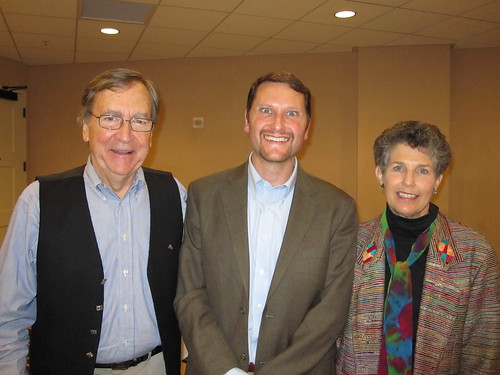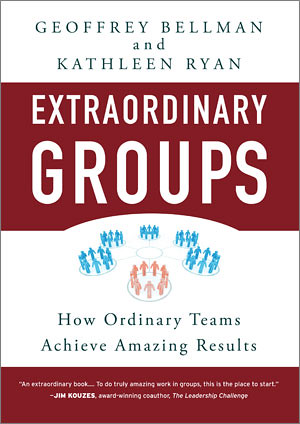I recently had the honor and privilege of sitting down with Geoff Bellman and Kathleen Ryan, co-authors of the new book Extraordinary Groups: How Ordinary Teams Achieve Amazing Results. What a treat! Geoff has been a personal idol of mine ever since I started my doctoral program more than 15 years ago, and Kathleen may now be my newest favorite OD consultant. Whether I’ve known them long or short, both are tremendously caring and generous souls who are ever-so-graciously giving back to the field of OD these days just as they have given to their local Seattle community for many, many years.
So why do you, our blog readers, care about Geoff and Kathleen? Because they are two leading team performance experts who just published an eye-opening book……that clearly demonstrates why some groups just come and go while others produce that “wow” experience that inspires us to achieve exceptional results. According to their Group Needs Model, anyone (yes, I said ANYONE!) can create extraordinary group experiences and produce greater results. Listed below are the 6 common needs people have when they join groups, and as Geoff and Kathleen discussed in our interview, groups can achieve remarkable outcomes even if only 2 of these 6 needs are met.
• Acceptance of Self while moving toward One’s Potential
• A Bond with Others that grows while pursuing a Common Purpose
• Understanding the Reality of the World while collectively Making an Impact
Please read their book! It’s written for everyone – project managers, senior executives, group facilitators, and trainers, and really anyone who leads or participates in professional or social community groups. This short video clip about the Group Needs Model was just a snip-it of our extensive interview together. We’ll be sharing a complete transcript of the entire interview very soon so you too can find out how to create extraordinary group experiences that produce outstanding team results.









I’m an independent consultant and the World Bank is one of my clients. I do coaching, change management consulting, team-building, facilitation and other stuff. A client at the World Bank asked for a day-long teambuilding session. I have a list of team models I like to use for this purpose. I had skimmed the book, and decided to use the 6-need model for this session. Obviously, I took a deep dive into the book first…
Before I report back, I have to say this was a special client: a brand new team: nine team members from about 6 nationalities (I say about because some had 2 and even three nationalities) with incredible professional lives and travels behind them, and a fabulous world-changing purpose, I’d love to share it but I guess I should not.
I was feeling a bit queasy about the model: those were very highly educated people with a heavy cognitive focus, those Argyris described as having a hard time learning. Not used to talking about their feeling. I had actually struggled to design my session. I didn’t always find the book easy to integrate, between the 8 extraordinary group indicators, the 6 needs, the four feelings of transformation. How do they play with each other, where does it start, etc.
Well, I won’t keep you waiting any longer. The session was a powerful success. They want more, beginning with another session in January. I actually showed them a couple of more analytical team models to explain why I had decided on the 6 needs model. What I found is that they could relate powerfully with their head and their heart to the 6 needs, not just from their work team experiences but from their lives. It resonated powerfully for them, and they found it easy to share why. They walk out of the session with little in the way of specific actions (except on communications, as they will be a virtual team) but a strong sense and commitment and a heartfelt understanding of what they needed to be successful.
Thanks for sharing your experiences with us Louis. It’s a powerfully simple yet provocative book with great lessons for us all. I’m glad to hear that you were able to apply it within your client setting. I can only imagine how differently the group will act now that they have this as the foundation for their work.
Take care.
Jeremy
Louis and Jeremy:
Geoff and I really appreciate your enthusiasm for Extraordinary Groups. Louis, I’m not surprised to read your report on how the Group Needs Model worked with your group. The two of us have been having similar experiences. In the presentations and workshops that Geoff and I have been doing, we start by asking people to reflect on a group experience that they think was extraordinary (without any definition from us); then we ask them to identify factors that enabled that experience to be so outstanding. Next we ask them to pair up or form small groups to briefly share their experience and compare the identified elements. At this point, the whole session takes off! No one wants to stop talking! I’ve honestly felt that at times I could just leave and people would be satisfied to simply continue theire conversations with one another. After about 10-15 minutes, however, we interrupt and begin to share what we found from our field study, then move on to other concepts. Establishing this connection between their own experience and the key points in the book makes it very easy for people to take in the concepts and be motivated to start applying them.